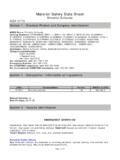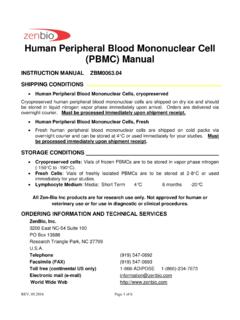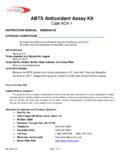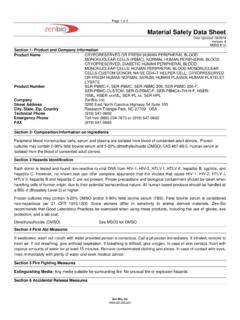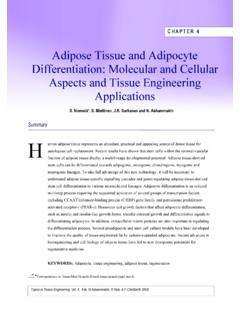Transcription of Guggulsterone Inhibits Adipocyte Differentiation …
1 16 VOLUME 16 NUMBER 1 | JANUARY 2008 | publishing groupadipocyte BiologyGuggulsterone Inhibits Adipocyte Differentiation and Induces Apoptosis in 3T3-L1 CellsJeong-Yeh Yang1, Mary Anne Della-Fera1 and Clifton A. Baile1,2 Objective: To determine the effects of Guggulsterone (GS), the active substance in guggulipid, on apoptosis, adipogenesis, and lipolysis using 3T3-L1 and Procedures: For apoptosis and lipolysis experiments, mature adipocytes were treated with GS isomers. Viability, apoptosis, and caspase 3/7 activation were quantified using MTS, enzyme-linked immunosorbent assay (ELISA), caspase-Glo 3/7 activity assay, respectively. The expression of cytochrome c was demonstrated by western blot. Lipolysis was quantified by measuring the release of glycerol. For adipogenesis experiments, postconfluent preadipocytes were incubated with GS isomers for up to 6 days during maturation.
2 Adipogenesis was quantified by measuring lipid content using Nile Red dye. Western blot was also used to demonstrate the Adipocyte -specific transcription factors peroxisome proliferator activated receptor 2 (PPAR 2), CCAAT/enhancer binding protein (C/EBP ), and C/EBP .Results: In mature adipocytes cis-GS decreased viability, whereas the trans-GS isomer had little effect. Both isomers caused dose-dependent increases in apoptosis and cis-GS was more effective than trans-GS in inducing apoptosis. cis- and trans-GS also increased caspase-3 activity and release of cytochrome c from mitochondria. In maturing preadipocytes, both isomers were equally effective in reducing lipid content. The Adipocyte -specific transcription factors PPAR 2, C/EBP , and C/EBP were downregulated after treatment with cis-GS during the maturation period.
3 Furthermore, cis-GS increased basal lipolysis of mature adipocytes, but trans-GS had no : These results indicate that GS isomers may exert antiobesity effects by inhibiting Differentiation of preadipocytes, and by inducing apoptosis and promoting lipolysis of mature adipocytes. The cis-GS isomer was more potent than the trans-GS isomer in inducing apoptosis and lipolysis in mature (2008) 16, 16 22. gum resin of the tree Commiphora mukul, has been used in Ayurvedic medicine to treat a variety of ailments, including obesity, arthritis, inflammation, and lipid disorders (1). The active compounds in this resin are the cis and trans isomers of Guggulsterone (GS) (4,17(20)-pregnadiene-3,16-dione) (2). The most studied effects of gum guggul and its component GSs are the lipid and cholesterol lowering effects. Early in vivo stud-ies showed that oral administration of gum guggul decreased the serum cholesterol level in hypercholesterolemic rabbits (3).
4 More recent studies have confirmed the clinical effect and have shown that this activity is at least partly due to the antago-nism of nuclear farnesoid X receptors (FXRs) by GS ((4,5); also reviewed in (1)).An Ayurvedic formulation containing gum guggul is also used for treatment of hyperlipidemia and obesity (1,3,6), and in one study oral administration of gum guggul alone was shown to decrease body weight in both animals and humans (2), although other studies have shown inconsistent effects (7). Recently, however, GS was shown to reverse the promotion of adipogenesis by FXR activation in 3T3-L1 preadipocytes (8). Thus, there may be a biochemical basis for the claimed anti-obesity effects of have studied a variety of natural compounds for their effects on the life cycle of the Adipocyte . For example, we have shown that ajoene, a compound from garlic, is a potent inducer of apoptosis in mature 3T3-L1 adipocytes (9).
5 Esculetin, a coumarin compound, both induced apoptosis and inhibited adipogenesis in maturing preadipocytes (10). Genistein, an isoflavone from soy, induced apoptosis of adipocytes in vitro, and when fed to ovariectomized female mice caused weight loss and induced apoptosis of adipose tissue (11). Because 1 Department of Animal and Dairy Science, University of Georgia, Athens, Georgia, USA; 2 Department of Foods and Nutrition, University of Georgia, Athens, Georgia, USA. Correspondence: Clifton A. Baile 8 March 2007; accepted 29 May 2007. | VOLUME 16 NUMBER 1 | JANUARY 2008 17articlesadipocyte Biologyof the potential antiobesity effect of GS and the involvement of FXR in adipogenesis, we carried out the following experi-ments to determine the effects of GS on specific phases of the Adipocyte life cycle: adipogenesis, lipolysis, and apoptosis in maturing preadipocytes and mature adipocytes.
6 In addition, we investigated some of the biochemical pathways involved in these and Procedurescell culture3T3-L1 mouse embryo fibroblasts were obtained from American Type Culture Collection (Manassas, VA) and cultured as described elsewhere (12). Briefly, cells were cultured in Dulbecco s modified Eagle s medium (DMEM) (GIBCO, Grand Island, NY) containing 10% bovine calf serum until confluent. Two days after confluency (D0), the cells were stimulated to differentiate with DMEM containing 10% fetal bovine serum (FBS), 167 nmol/l insulin, mol/l IBMX, and 1 mol/l dex-amethasone for 2 days (D2). Cells were then maintained in 10% FBS/DMEM with 167 nmol/l insulin for another 2 days (D4), followed by culturing with 10% FBS/DMEM for an additional 4 days (D8), at which time >90% of cells were mature adipocytes with accumulated fat drop-lets.
7 All media contained 100 U/ml of penicillin, 100 g/ml of strepto-mycin, and of 292 g/ml glutamine (Invitrogen, Carlsbad, CA). Cells were maintained at 37 C in a humidified 5% CO2 and antibodiesPhosphate-buffered saline (PBS) and DMEM were purchased from GIBCO (BRL Life Technologies, Grand Island, NY). cis- and trans-GS were purchased from Steraloids (Newport, RI). ApoStrand enzyme-linked immunosorbent assay (ELISA) Apoptosis Detection Kit was purchased from Biomol (Plymouth Meeting, PA). The viability assay kit (CellTiter 96 Aqueous One Solution Cell Proliferation Assay (con-taining 3-(4,5-dimethythizol-2-yl)-5-(3-carboxym ethoxyphenyl)-2-(4-sulfophenyl)-2H-tetra zolium assay reagent (MTS)) and Caspase-Glo 3/7 assay kit were purchased from Promega (Madison, WI). AdipoRed assay reagent was purchased from Cambrex (Walkersville, MD).)
8 Antibodies specific to polyclonal peroxisome proliferator activated receptor (PPAR) 2, CCAAT/enhancer binding proteins (C/EBPs), -actin, and cytochrome c were from Santa Cruz Biotechnology (Santa Cruz, CA). Antibodies specific to polyclonal anti-phospho-ERK 1/2 (Thr202/ Ty r204) and total extracellular signal-related kinase 1/2 (ERK 1/2) were from Cell Signaling Technology (Beverly, MA).Mts cell viability assayTests were performed in 96-well plates. For mature adipocytes, cells were seeded (5,000 cells/well) and grown to maturation as described above. Adipocytes were incubated with cis- and trans-GS (times and concentrations indicated in Results and figure legends). Prior to meas-uring viability, treatment media were removed and replaced with 100 l fresh 10% FBS/DMEM and 20 l MTS solution (Promega, Madison, WI).
9 Cells were then returned to the incubator for an additional 2 h before 25 l of 10% sodium dodecyl sulfate was added to stop the reac-tion. The absorbance was measured at 490 nm in a plate reader ( Quant Bio-Tek Instruments, Winooski, VT) to determine the formazan con-centration, which is proportional to the number of live assaysFor the assessment of apoptosis, the ApoStrand ELISA Apoptosis Detection Kit (Biomol, Plymouth Meeting, PA) was used. This kit detects single-stranded DNA, which occurs in apoptotic cells but not in necrotic cells or in cells with DNA breaks in the absence of apop-tosis (13,14). Tests were performed in 96-well plates. For mature adi-pocytes, cells were seeded (5,000 cells/well) and grown to maturation as described above. Prior to single-stranded DNA ELISA, adipocytes were incubated with cis- and trans-GS at the times and at the concentrations indicated in the Results and figure legends.
10 Thereafter, the treatment media was removed and the cells were fixed for 30 min and assayed according to the manufacturer s activity assayTests were performed in 96-well plates. For mature adipocytes, cells were seeded (5,000 cells/well) and grown to maturation as described above. Adipocytes were incubated with cis- and trans-GS (at the times and concentrations indicated in Results and figure legends). Thereafter, 100 l of caspase-Glo 3/7 (Promega, Madison, WI) reagent was added to each sample and the cells were incubated for 1 h and assayed accord-ing to the manufacturer s red o stainingcis- and trans-GS along with dimethyl sulfoxide control were added along with the induction medium for days 0 2, 2 4, or 4 6 of adipogenesis. The medium was changed every 2 days. On day 6, cells were stained with Oil Red O.


